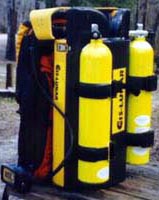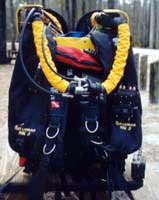 | |
           2026 Sistema Cheve |
Wakulla 2 Technology
Rebreathers There are two principal architectures used in the design of portable life-support apparatus. These are open-circuit and closed-circuit systems. Open-circuit apparatus, popularized by Cousteau, employs a compressed-gas supply and a demand regulator from which an individual breathes. The exhaust gas is ported overboard with each breath, hence the name "open" circuit. A great deal of useable oxygen still present in the exhaled breathing gas is lost in this manner. Furthermore, the volume of gas expelled with every breath increases with depth. At 100 m depth a standard sport-diving cylinder will provide approximately 30 breaths through an open-circuit regulator before the tank is completely empty. It was this type of apparatus that was used by all exploration teams at Wakulla Springs in 1987. In a closed-circuit system nearly 100% use is made of the oxygen content of the supply gas. This is done by recycling the exhaust through a scrubbing mechanism which removes the carbon dioxide. Gas is added to the system by means of a computer-operated valve when the oxygen content falls below a user specified level. Pound for pound, a fully closed-circuit system will be approximately 200 times more efficient than open-circuit apparatus at the operating depths encountered in Wakulla Springs. During the 1987 project, the Cis-Lunar MK-1 mixed gas rebreather (helium-nitrogen-oxygen) was successfully tested. Since then, extensive work has resulted in the Cis-Lunar MK-5P. The MK-5P, being a fifth generation device, has benefited from years of development and thousands of hours of in water use. The MK-5P offers an extraordinary level of performance and redundancy. The MK-5P capabilities include:
 For the Wakulla 2 project, the MK-5P has been further refined into a dual version, the MK-5R system. This design consists of two fully independent MK-5P rebreathers. Thus, the inherent redundancy in the MK-5P is further enhanced by each diver having two complete rigs. The primary device is mounted on the diver's main scooter, while the redundant (backup) rig is mounted on the diver's back. One of the unique features of the MK-5R system is the introduction of the underwater pluggable system connectors (i.e., the breathing hoses) which allow a diver to switch between the vehicle-mounted life support system and the backup rebreather in less than 30 seconds at 100 m water depth. Since the MK-5P has a minimum 6 hour range at any depth (and up to 12 hours for metabolically efficient divers), explorers using the MK-5R system will have at least 12 hours of life support capability. It must be noted that this level of life support is carried with the diver at all times and does not rely on staging techniques. |
| Copyright © 2025 U.S. Deep
Caving Team, Inc. All rights reserved. Todo el contenido tiene derechos de autor del U.S. Deep Caving Team. Todos los derechos reservados. No portion of these pages may be used for any reason without prior written authorization. | |

